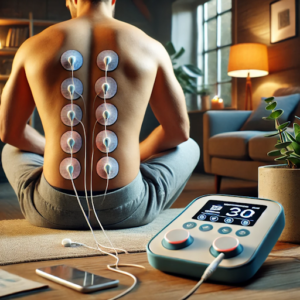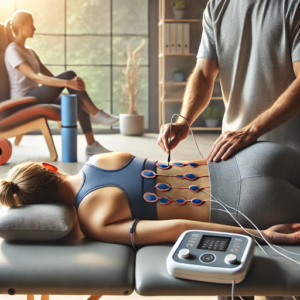Effectively Managing Back Pain Through Electrotherapy
Back pain is a widespread issue affecting millions worldwide, transcending age, gender, and lifestyle factors. It can manifest in various ways, from sharp discomfort lasting a few days to chronic pain that persists for months or years. Often, back pain stems from a combination of physical, psychological, and environmental factors.
Common causes of back pain include muscle strain, herniated discs, arthritis, and poor posture. The variability in how back pain is experienced complicates diagnosis and treatment. While some may find the pain tolerable, others could be severely debilitated, requiring a comprehensive approach from healthcare professionals.
Beyond physical health, chronic back pain can take a toll on emotional well-being, often leading to anxiety, depression, and social isolation. The economic implications are substantial, as back pain is one of the leading causes of disability and reduced productivity in workplaces.
Understanding the underlying causes of back pain is crucial for developing effective treatment strategies. One such strategy is electrotherapy, which has gained recognition for its ability to relieve pain and promote recovery.
Summary
- Back pain may result from factors like poor posture, muscle strain, or injury and significantly impact daily life.
- Electrotherapy is a non-invasive technique that uses electrical energy to manage pain and promote healing.
- Electrotherapy offers pain relief, muscle relaxation, improved circulation, and reduced inflammation.
- Different electrotherapy methods like TENS and EMS can help alleviate back pain.
- When using electrotherapy, it’s important to follow healthcare professional advice and avoid using it near the heart or on broken skin.
 Introduction to Electrotherapy
Introduction to Electrotherapy
Electrotherapy refers to various techniques that use electrical energy to treat conditions like back pain. This therapeutic approach has evolved, utilizing advanced technologies to offer pain relief and promote healing. Electrotherapy can target specific areas of discomfort by stimulating nerves and muscles through electrical impulses.
Unlike medications, which may cause side effects or dependency, electrotherapy is non-invasive and effective in managing back pain. As research continues, the benefits of electrotherapy are becoming more widely recognized, leading to its integration into comprehensive pain management plans.
Benefits of Electrotherapy for Back Pain
One of the primary benefits of electrotherapy is its ability to provide immediate pain relief. Elect electrotherapy interrupts pain signals by sending electrical impulses to the affected area, reducing discomfort.
Additionally, it promotes the release of endorphins, the body’s natural pain relievers, further enhancing its effectiveness. Electrotherapy also improves blood circulation and reduces inflammation, supporting the healing process. This combination of immediate and long-term benefits makes electrotherapy a valuable tool for managing back pain.
Types of Electrotherapy for Back Pain
Electrotherapy encompasses various methods, each targeting different aspects of back pain management. TENS (Transcutaneous Electrical Nerve Stimulation) is a popular technique that delivers low-voltage electrical currents to relieve pain. Its portability and ease of use make it ideal for home treatment.
IFC (Interferential Current Therapy) uses medium-frequency electrical currents to reach deeper tissues and address musculoskeletal issues. Additionally, EMS (Electrical Muscle Stimulation) and microcurrent therapy are increasingly recognized for stimulating muscle contractions and aiding tissue repair.
 How to Use Electrotherapy for Back Pain Management
How to Use Electrotherapy for Back Pain Management
Following specific guidelines is crucial to ensuring safety and effectiveness when using electrotherapy. Patients should consult a healthcare provider to determine the best electrotherapy option. Once a treatment plan is in place, therapy can be administered in a clinical setting or with portable devices at home.
Home users must follow the manufacturer’s instructions for electrode placement, intensity, and session duration. A typical session lasts between 20 and 60 minutes. Consistency is key, as regular treatments offer cumulative benefits over time. Regular communication with a healthcare provider is essential to track progress and make adjustments if needed.
Precautions and Considerations When Using Electrotherapy
Although electrotherapy is generally safe, certain precautions should be taken to avoid complications. Individuals with heart disease, epilepsy, or implanted devices like pacemakers should consult a healthcare provider before using electrotherapy. Pregnant women are also advised to avoid electrotherapy near the abdomen or lower back.
It is important to avoid placing electrodes on open wounds or infected areas. Patients should also monitor their bodies for adverse reactions during treatment and stop immediately if they experience increased pain or skin irritation.
 Integrating Electrotherapy with Other Back Pain Management Techniques
Integrating Electrotherapy with Other Back Pain Management Techniques
Integrating electrotherapy with other treatments can enhance back pain management. A holistic approach often yields better results than relying on a single therapy. Combining electrotherapy with physical therapy can strengthen muscles and improve flexibility while addressing underlying musculoskeletal problems.
Making ergonomic adjustments at work or home can further enhance the benefits of electrotherapy by reducing strain on the back. Additionally, incorporating stress-reducing practices like yoga or meditation can help alleviate pain perception by promoting relaxation.
FAQs
Can you tell me about electrotherapy for back pain?
Electrotherapy uses electrical stimulation to manage and relieve back pain—standard methods in inStandardTENS and EMS.
How might electrotherapy help with my back pain?
Electrotherapy stimulates nerves and muscles to improve blood flow, promote healing, block pain signals, and trigger the production of endorphins, the body’s natural painkillers.
Is it safe to use electrotherapy for back pain?
Electrotherapy is generally safe when guided by a trained healthcare provider. Follow recommended protocols and avoid applying the device near the head or heart.
How does electrotherapy work for back pain?
Electrotherapy relieves pain, reduces muscle spasms, and improves flexibility. It’s a non-invasive and drug-free option for managing back pain.
Who can benefit from electrotherapy for back pain?
Electrotherapy may benefit individuals with conditions such as strained muscles, arthritis, sciatica, or herniated discs as part of a broader pain management strategy.
Are there any situations where electrotherapy isn’t recommended?
Electrotherapy is not recommended for individuals with pacemakers, epilepsy, or heart conditions. Consult a doctor before starting treatment.
Brought To You By: Back Pain Therapy
The Article: Managing Back Pain with Electrotherapy appeared first on https://mcrtherapies.co.uk
The Article Managing Back Pain with Electrotherapy appeared first on https://mcrtherapies.com
The Article Managing Back Pain with Electrotherapy Was Found On https://limitsofstrategy.com


The complex nature of back pain truly exemplifies the intersection of physical health and emotional well-being. As someone who has navigated the challenges of chronic back pain, I can attest to the multifaceted impact it can have on daily life. Initially, I found myself focused solely on physical remedies—physical therapy, stretches, and even pursuing various treatment options like electrotherapy. However, over time, I realized that addressing the psychological aspects was equally important.
It’s great to hear your take on this – you hit the nail on the head with the whole mind-body connection thing. It’s pretty wild how we can get so wrapped up in chasing after physical fixes that we sometimes forget our heads and hearts are in the mix too. I remember when I thought yoga was just a fancy way to meditate until I realized I was just hyper-focusing on my breathing while trying not to topple over in downward dog.
You bring up a really interesting point about how we often overlook the mind while pursuing physical health. It’s such a balance, right? I used to think yoga was just about bending and stretching, but once I actually started focusing on the mind-body connection, it felt like a whole new world opened up. I found that those moments when I’m trying not to fall over in downward dog can actually help clear my head more than any meditation session I’ve tried.
You’re so right about that mind-body connection—it’s often overlooked in our quest for physical health. I remember when I first got into yoga, I thought it was all about the physical poses too. But once I started tuning into my breath and really being present on the mat, it transformed the experience for me. It’s kind of fascinating how something that seems so simple can have such profound effects.
I completely resonate with what you’re saying about the mind-body connection. When I first started exploring meditation alongside yoga, I had a similar realization. It was amazing to discover that the stillness and mindfulness we cultivate can really change how we approach not just our practice, but life in general.
It’s interesting how our perceptions of practices like yoga can shift over time, isn’t it? I used to feel similarly—thinking yoga was just a physical activity, something to do to stay fit. But the deeper layers, the mindfulness and emotional awareness aspects, are what really drew me in. It’s like once you start to embrace that mind-body connection, you realize it’s not just about the asanas but about listening to what your body and mind are telling you.
I can really relate to what you’re saying about how perceptions of yoga can evolve. Initially, I viewed it as just another workout, a way to get stronger and more flexible. But over time, as you mentioned, I found myself drawn into that deeper layer of mindfulness and emotional awareness. There’s something quite transformative about really tuning in to your body and mind, isn’t there?
I can really relate to that shift in perception; it reminds me of how understanding different therapies can deepen our awareness, especially when managing pain—like the insights I found on effective sciatica relief that go beyond just physical treatments.
‘Sciatica Relief: Best Therapies for Managing Pain Effectively’
https://lvabj.org/sciatica-relief-best-therapies-for-managing-pain-effectively/.
It’s great to hear how your perspective on yoga has shifted—there’s something profound about that journey. When we start to see it just as a workout, it feels more like a checklist, but as we dive deeper into the practice, we unlock layers that speak to our emotional and mental states. That connection to our body and mind can be a game changer.
I really appreciate your insights on how perceptions of yoga can shift. It’s fascinating how a practice that starts with a focus on physicality can open the door to deeper emotional and mental exploration. For me, that transition happened gradually, too. Initially, I was all about the flexibility and strength gains, but as I immersed myself in the practice, I began to notice how it affected my mood and stress levels. That connection between body and mind is something I think many people overlook when they first approach yoga, and it’s a game-changer when you tap into it.
You bring up a critical point about the intersection of physical health and emotional well-being in the context of chronic back pain. The journey you describe is one that many can relate to, often starting with an intense focus on the physical aspects of pain—those familiar doctor visits, treatments, and therapies that seem to dominate the narrative. We can easily get caught in a whirlwind of physical solutions, believing that if we just find the right set of stretches or therapies, we’ll emerge victorious from our back pain battles.
You’ve really nailed it when it comes to the often overwhelming focus on the physical side of managing chronic back pain. I think it’s so easy to get trapped in that cycle of doctor visits and trying to find that perfect therapy or set of stretches. I know I’ve been there, pouring over different programs and advice, sometimes feeling like I was on an endless quest for a cure.
I completely relate to your experience; I recently came across an interesting perspective on how infrared light therapy can play a role in addressing both the physical and emotional aspects of pain management.
‘Infrared Light Therapy: Harnessing Its Healing Power for Pain Relief’
https://lvabj.org/infrared-light-therapy-harnessing-its-healing-power-for-pain-relief/.
I completely resonate with what you’re saying about the cycle of doctor visits and searching for the perfect therapy. It’s a bit of a rabbit hole, isn’t it? Sometimes it feels like the more we search for solutions, the more overwhelmed we become. It’s easy to lose sight of the wider picture — like the emotional toll that chronic pain can take on us, not just physically but mentally and socially as well.
I completely agree; it can feel like a never-ending loop of appointments and searches. I find that with each new recommendation or therapy, there’s often a glimmer of hope followed by a sense of frustration when things don’t pan out as expected. It’s almost as if the more options are available, the harder it becomes to just find relief.
Ah, the cycle of searching for relief—it’s like being on a merry-go-round, except there’s no music and the only prize at the end is a headache. Each new recommendation or therapy might feel like a shiny new toy, but when it doesn’t deliver the goods, it’s a letdown that could rival the disappointment of finding out your favorite cereal doesn’t come with a free toy anymore.
I completely resonate with what you’re saying. It can feel so overwhelming at times, especially when each new recommendation carries that initial spark of hope. I remember a period when I was juggling various therapies and treatments, and it really was a rollercoaster of emotions. You’d get so invested in the idea that something might finally bring relief, only to feel that familiar wave of frustration when the results didn’t meet expectations.
I totally get that feeling of frustration; I recently came across some interesting insights on a therapy that seems to offer new hope for back pain relief, and it might be worth checking out.
‘Red Light Therapy: Effective Back Pain Relief’
https://lvabj.org/red-light-therapy-effective-back-pain-relief/.
I can really relate to that feeling of getting stuck in a cycle of doctor visits and therapy searches. It’s like every appointment leads down another path or introduces yet another option to consider, and it can definitely feel overwhelming. It’s intriguing how chronic pain impacts us on so many levels, isn’t it? The emotional and social aspects often get overshadowed by the physical symptoms, but they’re so deeply intertwined.
You make a great point about how easy it is to get lost in the maze of physical treatments when dealing with chronic back pain. It often feels like a never-ending search for the next big solution, and it can be frustrating.
Understanding the multifaceted nature of back pain is crucial, especially as it intersects with so many aspects of daily living. I found your discussion on the complexities of back pain to be particularly relatable, as many of us navigate both the physical and emotional layers of this condition every day. My experience with back pain has revealed just how deeply it can affect not only one’s physical health but also mental well-being and overall quality of life.